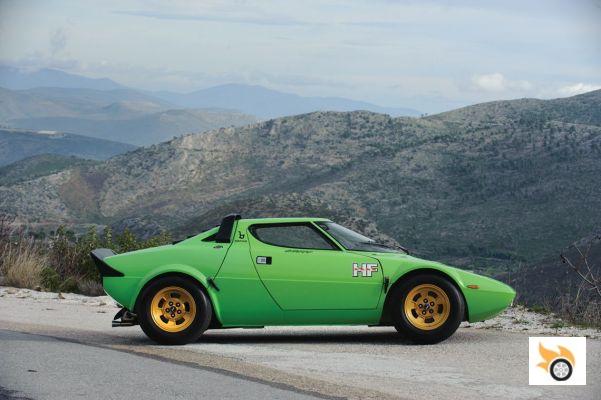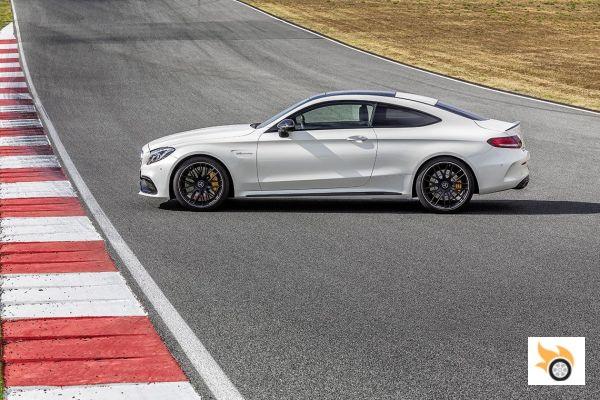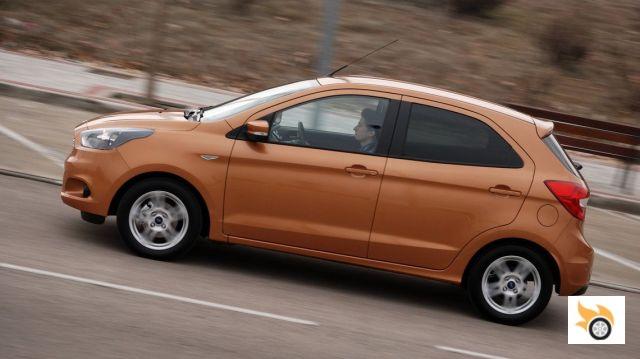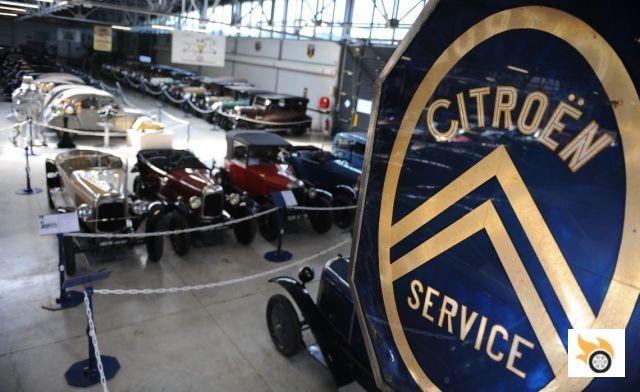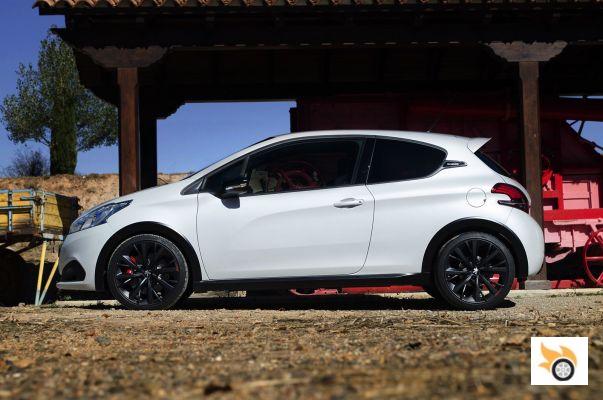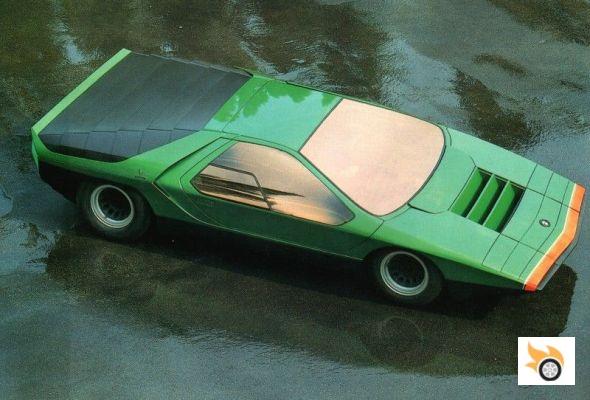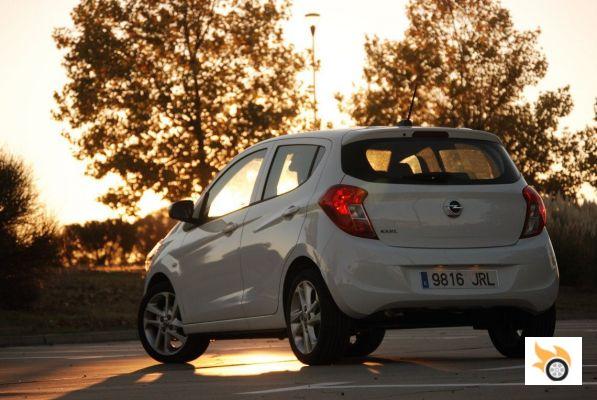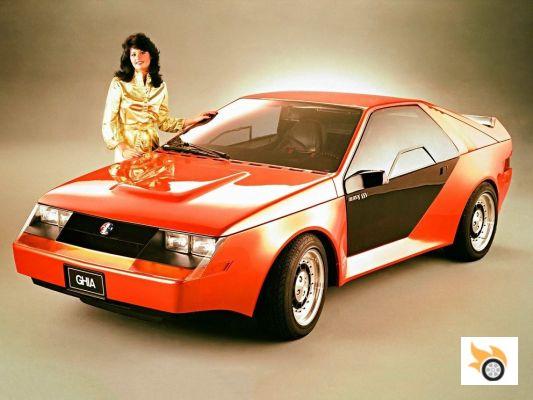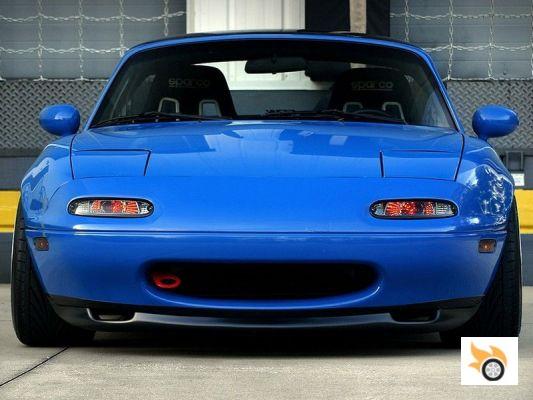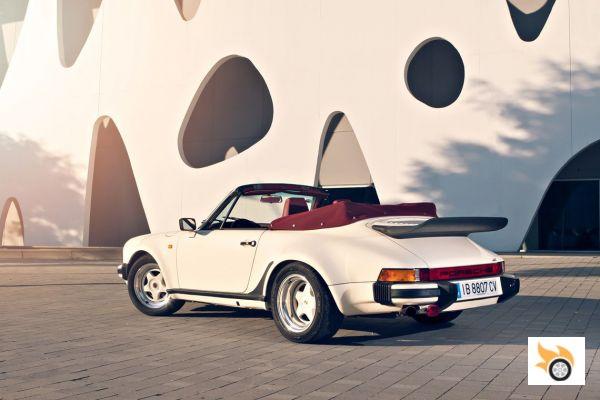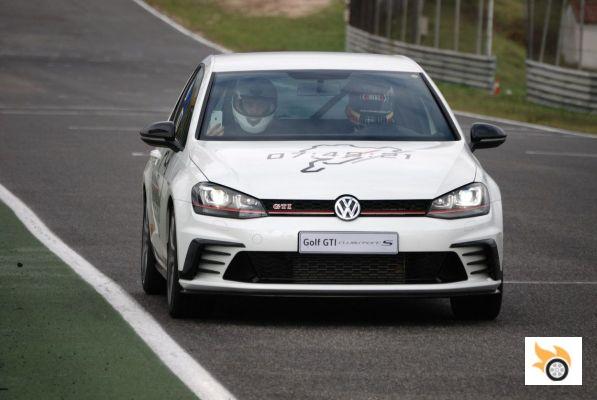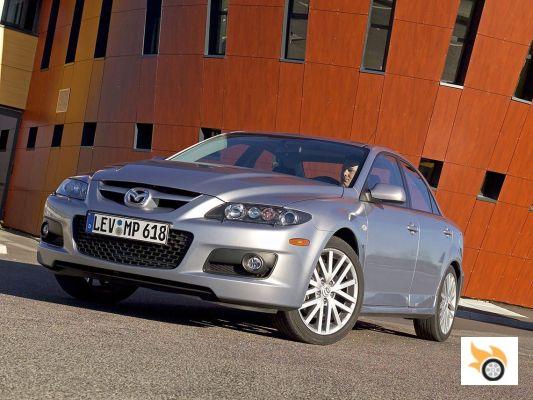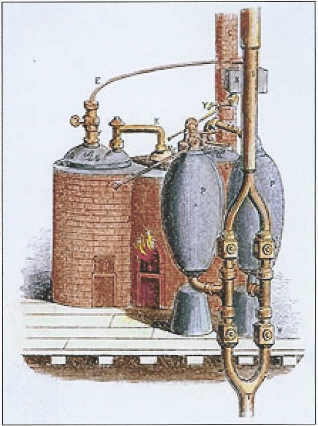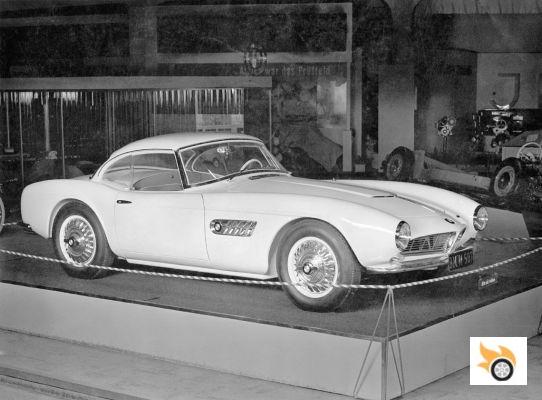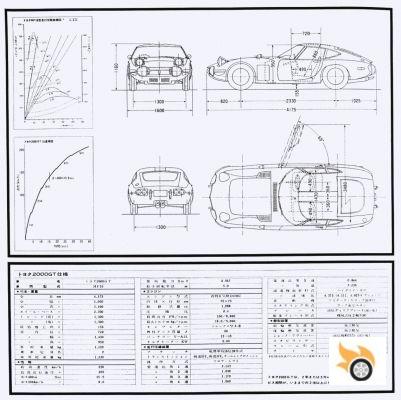
A bit of history
Toyota's origin comes from the manufacture of trucks and military vehicles, and before that, from the manufacture of looms. In 1933 it began to manufacture passenger cars for civilian use, but they were too conventional and did not arouse any passion. Since 1957 it had a division for competition called TOSCO -TOyota Sports COrner, renamed TRD since 1976- reaping numerous successes during these years. For these reasons, back in 1964 after the second Japanese Grand Prix, seeing the success of attendance and media coverage, Taizo Ishida, president of Toyota, decided that the company should go up a step in its internationalization, offering a GT to compete with the best sports cars of the time and orienting the brand image towards sportsmanship. He picked up the phone and spoke to Shoichi Saito, to whom he entrusted the task of creating a sports car far superior to the Sports 800: the 2000GT project was born.
"Do whatever it takes, not only to produce the 2000GT, but to make it one of the best; or maybe even the best car in the world." - Shoichi Saito
Shoichi's first step was to look at the best sports cars of the time: Ferrari 250GTO, Jaguar Type-E, Porsche 911 and Lotus Elan. It is said that they bought a model of each of them, in order to keep the best of each. After their analysis, they decided that the best chassis was Lotus, the best engine was Jaguar, the best gearbox was Porsche and the most original design was Ferrari. They had their targets to beat. They got down to work and in 1965 they presented the "280 A1" prototype at the Tokyo Motor Show: the Toyota 2000GT, the first Japanese supercar, had just been born.
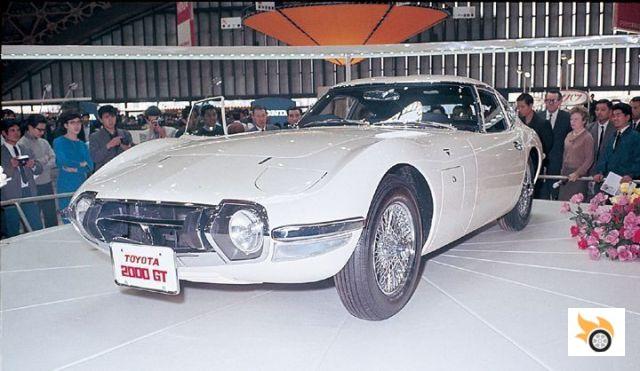
After this presentation, which was a great success among the public, the work of moving to production began, and here came the difficult part: the company did not have the technical capacity to manufacture such a powerful engine, so they looked for a Japanese supplier who could get them out of trouble. At that time Yamaha Motor Corporation, which was already making motorcycles, had years earlier developed a GT prototype for Datsun (what we know today as Nissan), the A550X project; but the deal had already ended as Datsun had scrapped its production. This was ideal for Toyota, who found in Yamaha the perfect ally to manufacture the 2000GT engine, taking advantage of their experience. They signed a collaboration agreement, where Yamaha would supply the engines and some other parts.
From here, two prototypes were built, lightened and tuned by TOSCO, to test and participate in local competitions. One of them, which we will talk about later, was the one that in October 1966 broke 16 speed records, as part of the reliability tests that Toyota wanted to carry out before going into production. After all the tests and adjustments, the Toyota 2000GT was marketed in May 1967. Thus began to roll the best Japanese sports car to date, which would later be succeeded by the Supra.
A total of 351 units were manufactured, of which 337 were street cars, and 14 were dedicated to competition.
Of the 351 units, 233 correspond to the MF10 chassis (1967-1969), 109 to the MF10L (1967-1969) and 9 MF12L (1969-1970). The "L" designation corresponds to the left-hand drive configuration.
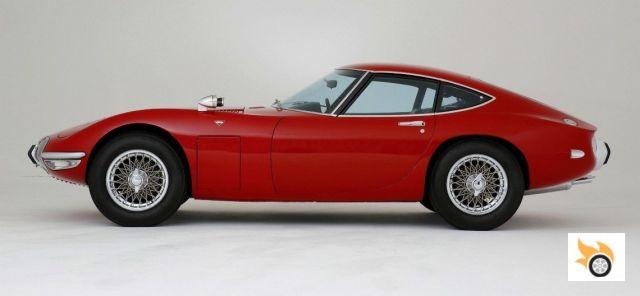
Design
Shoichi Saito put Jiro Kawano, product manager at the time, in charge of the design. Jiro, in turn, relied on Satoru Nozaki, a young industrial designer who had recently joined the brand. Some say that the 2000GT is Satoru's work, others say Jiro's work. In any case, both were directly involved in the realization of this wonderful design.
Let's start with the front end. The first thing that stands out is that it has 4 headlights: two of them are inspired by the S800, and the other two are retractable. Why? The Toyota 2000GT was born with a vocation to be sold all over the world, especially in the United States. And there the laws in California were very strict with the minimum height of the headlights. That's why the designers added the retractable headlights, which weren't really necessary, except for the Californian legislative issue. Since they were available, the retractable headlights were dedicated to the low beams, while the integrated ones were used for the high beams.
We appreciate its sharp design, with the grille inscribed between the main headlights, and the characteristic mirrors on the fins; it is another detail directly influenced by Japanese legislation.
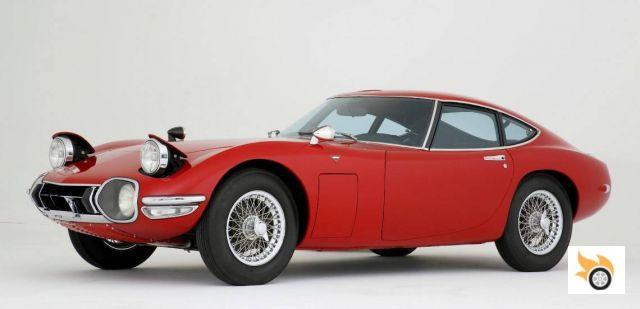
Its windshield is quite small, as the overall height of 1,160 mm limited this proportion, making the living area was quite small.
The turn signals taken to the side of its 1.6 meters, just below two chrome finials that act as bumpers, culminate this front.
The side is perhaps the most striking view: infinite nose, short overhangs, low height and almost perfect proportions, respecting the rule of thirds. It had a length of 4,175 mm and a wheelbase of 2,330 mm. If you look closely, it is almost identical to the Ferrari 250GTO, with subtle differences such as the second window, which slopes upwards to meet the roof line. The waistline emphasizes the wheel arches, making the line flow towards the rear. The slightly sloping windscreen and the smoothly falling roof make this design one of the most harmonious of the era, along with the 250GTO.
A couple of details: did you notice those little hatches between the wheel and the door? Since there was plenty of room with such a long nose, the designers decided to use it. In the compartment on the right side (passenger), the battery is located. And on the left side, the air filter and the water tank for the windshield. This way they managed to lower the center of gravity a few centimeters. Although the position of the battery seems to me to bring advantages, taking the air behind the wheel, does not seem the most efficient for the flow of dirty air and splashes that can be. We can not leave the side view without mentioning its chrome door openers, which start flush, and then make a smooth curve, returning to merge with the body. A very stylish detail.
At the rear we can see the narrowing of the C-pillar, to carry the air flow more smoothly, and the detail of the central indentation of the roof, very Zagato style with its double bubble roof. Two round lights on each side finish off the rear, which has no bumper except for two bumpers right in the middle. Another very sporty detail: double exhaust tailpipes right in the middle of the lower part, E-Type style.
From my point of view, this is one of the most beautiful designs of the time. Many may say that it copies features from the Ferrari 250GTO or Jaguar E-Type, and they are right; but despite being inspired by them, I think the designers managed to give the 2000GT its own personality.
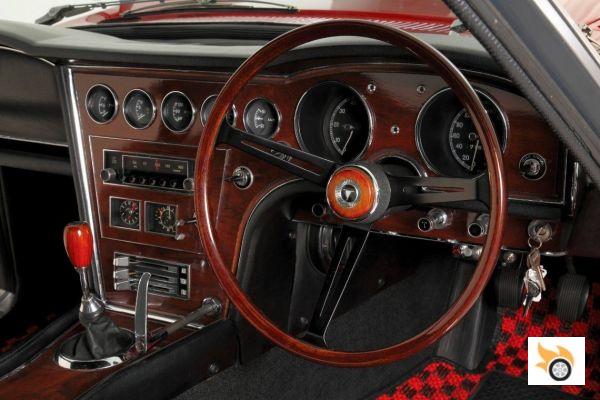
Cockpit
Let's move on to the interior. As we can see, there's a lot of wood as decoration. And it's not just any wood, as it was provided by Yamaha, being the same wood that Yamaha uses for its high quality piano manufacturing. The wooden steering wheel and three chrome spokes, presides over the driving position with two large dials for revs and speed. The ignition key next to the door, a very Porsche detail, followed by the light and wiper controls, just below the steering wheel. It doesn't look like a very ergonomic place. If you notice, there are no satellites on the steering column. The turn signals are operated with a long push button switch, just above the ignition key.
The wood in the cockpit was used by Yamaha to make their pianos.
On the center console we find plenty of information: 5 gauges for fuel, coolant and oil temperature, oil pressure and amperage. Just below is the radio, then a clock and stopwatch and finally the heating controls. Above the central tunnel the gear lever finished in wood, and right next to it the handbrake, very original and functional, being integrated into the overall design.
Inside the interior space is just enough for two people, provided they were not very high. With a total height of 1.16 meters, the interior space is quite small. On the other hand, the 2000GT offers us Formula 1 sensations, as we are seated in a really low position. It must be taken into account that this is a sports car with a soft, but pronounced roof drop. Because of this, the boot space is reduced to a minimum behind the seats. I don't think this was a big problem for the buyers, as they were probably looking for other objectives with their purchase, and this would be their second or third car. Something more intended for a weekend of sensations on the road.
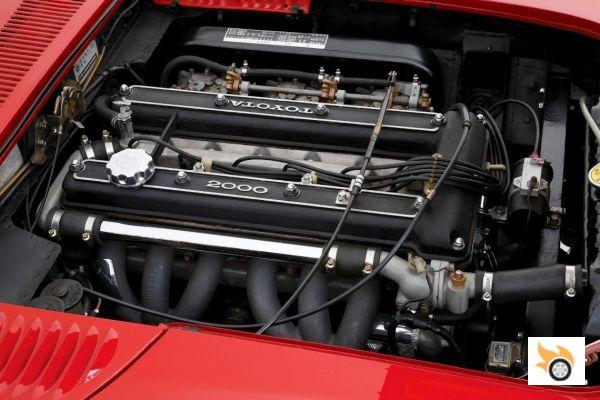
Technology
Let's take a look at the ins and outs of the 2000GT, starting with its chassis. As we have already mentioned, it is based on the Lotus Elan chassis with an "X" shape, made of steel. This type of chassis makes the construction cheaper and lighter than a monocoque, having also very good dynamic behavior and allowing the access door to be located in a position closer to the ground.
For the bodywork, aluminium was chosen, given its lightness and resistance, except for the rear hatch, made of fibreglass. It was handmade, by hand. As for its configuration, it is a vehicle with a longitudinal engine placed in a central front position, and rear propulsion. With this configuration a good weight distribution was achieved, leaving 48% on the front axle and 52% on the rear axle, which guaranteed good traction.
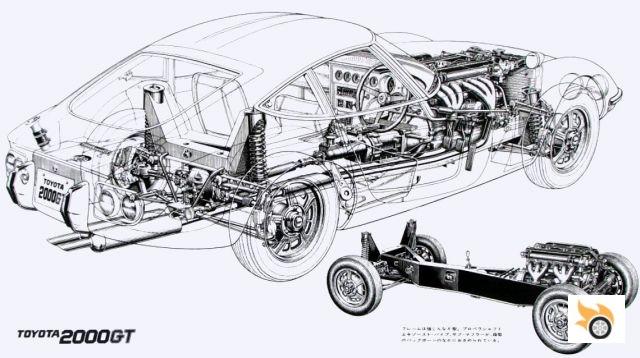
For the suspensions, they opted for the same solution as Lotus: double arm on both axles, made of steel. As a detail to mention that in the rear axle the shock absorber and spring are anchored to the upper arm. This configuration worsens the packaging, the scrub radius, and the movement ratio of the spring-shock set, although it provides the benefit of leaving more space for the drive shafts. If you look at the picture, the lower arms of the rear suspension are angled quite steeply, pointing towards the center of the vehicle. This is done to have a higher rear roll center than the front. If you have any doubts with these concepts, you can refresh your memory here.
It was fitted with Dunlop 165 HR 15 tyres on magnesium rims, together with disc brakes on all four wheels; the sportiest thing available at that time. All in all, it weighed in at 1,120 kg, more than a Porsche 911S, but less than an E-Type.
Let's move on to the engine. It is an inline 6-cylinder with 1988 cc, from the Toyota Crown, but suitably improved by Yamaha, who added an aluminium cylinder head, with double overhead camshaft and cross-flow architecture. With this they managed to extract 150 hp and 175 Nm. It was slightly less than the Porsche 911 with its 180 hp and considerably less than the Jaguar E-type with 265 hp, although the displacement of the Jaguar was more than double. It was a quite elastic engine that reached 7,500 RPM. The engine was coupled with a five-speed synchromesh gearbox, where they implemented their own version of the synchromesh invented by Porsche. It wasn't quite as smooth, but it was a major improvement over the previous gearboxes Toyota had made.
The Toyota 2000GT did 0-100 km/h in just over 10 seconds - reaching 205 km/h - a very remarkable figure in the late 60s.
You can see the data of its specifications in the image. And if you want to see it in motion, I leave a video of the time where they make an in-depth analysis, yes, in Japanese. Try with the automatically generated subtitles.
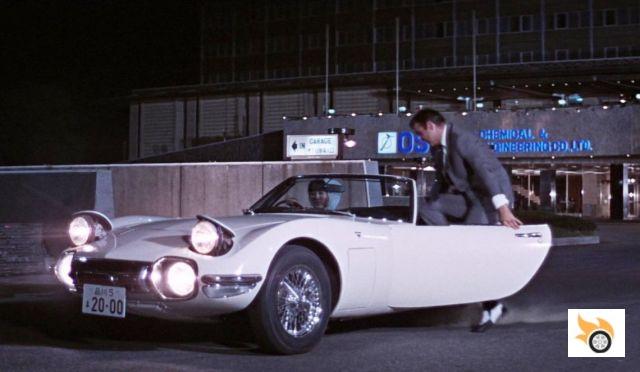
Curiosities
Let's see now some very interesting curiosities about this Toyota:
- It was presented at the 1965 Tokyo Motor Show.
- The chassis was a copy of the Lotus Elan.
- The engine was based on the Toyota Crown Sedan engine.
- The final engine was manufactured by Yamaha Motor Corporation
- The wood in the passenger compartment was the same as Yamaha used in their pianos
- Only 351 units were produced - 337 road cars - between 1967 and 1970, of which about 50 went to the US
- The price at the time was $6,800 - about €49,000 today - $1,000 more expensive than a Jaguar E-Type or Porsche 911 and about $2,500 more than a Chevrolet Corvette
- In 2014, a 1967 unit was auctioned off for more than a million dollars
- Road & Track magazine in 1967 said it outperformed the Porsche 911 in some respects.
- It was James Bond's car in "You Only Live Twice."
- Toyota had to make a cabrio version especially for the film, of which two units were made, as Sean Connery could not fit in the original 2000GT
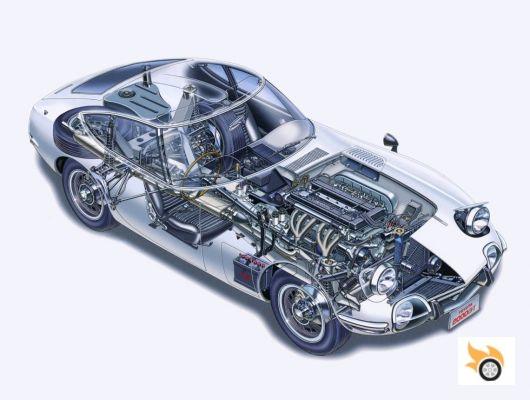
- It is the favorite "Bond" car of Daniel Craig, current 007.
- Shin Yoshikawa, the master of the cutaway, published a book about the 2000GT, with a print run of 10,000 copies. It only sold 1,500.
- In May 1966 the 2000GT takes third place in the Japanese Grand Prix.
- In June 1966 the 2000GT competed in the Suzuka 1000 km, winning the race for the first time for Toyota and also taking second place.
- In October 1966, a Toyota 2000GT pre-series car completed 78 hours of continuous speed testing at the Yatabe oval circuit, breaking 13 international records, and 3 world records.
- In 1967, Toyota races in the Fuji 24-hour endurance race, winning the championship.
- In June 2015 Toyota unveiled a GT86 dressed in the colors of the Yatabe race.
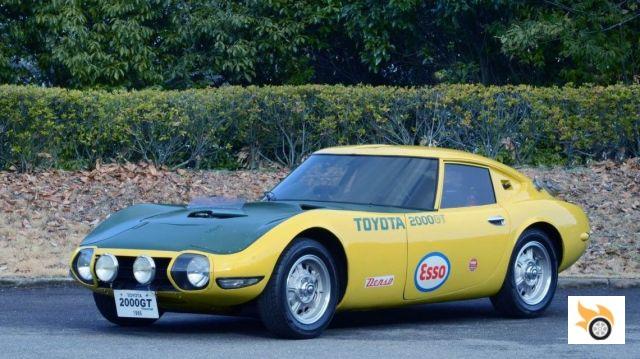
The Yatabe speed test
We can't finish the article, without talking about its main reason. A year before the commercialization of the Toyota 2000GT, its engineers decided that it was time to test the resistance of its components, mainly its engine. They thought it would be a good idea to prepare a lightened pre-series model, and take it to the Yatabe oval circuit, to run non-stop for 3 days and see where the weak points of the car were. And that's what they did. They prepared the test for months, until October 1966 arrived. There was the Toyota 2000GT Speed Trial, in yellow with green bonnet, made by TOSCO for the occasion. A team of five drivers, dozens of mechanics and official timekeepers accompanied the model, as well as Toyota's top brass, with Shoichi Saito at the helm.
TOSCO, Toyota's racing division, prepared a lightened Toyota 2000GT in yellow and green.
The test started in good weather. The car was running well, making the obligatory stops to refuel, change tyres and change drivers every few hours. The next day a typhoon hit Japan, and a big storm arrived in Yatabe. No matter what, the Toyota 2000GT had come to race, and that didn't stop it from continuing at full speed through the downpour, day and night. As the sun went down, only the roar of its engine could be heard, and the trail of its lights could be seen, while the Toyota team dined on misoshiru and some sushi. The official timekeepers looked at the high-precision Seiko stopwatches, with their vacuum valve digits. They noted down the lap times and they were recorded. In another part of the circuit, next to the stacks of Goodyear tyres, some mechanics were trying to get some sleep.
Finally, on the third day, after 78 uninterrupted hours at top speed, the race was over. The Toyota 2000GT had broken 13 international speed records and three world records. Quite a feat for a pre-production vehicle, typhoon included.
The 13 international records were:
- 6 hours: 210.42 km/h
- 1,000 miles: 209.65 km/h (120.35 mph)
- 2,000 km: 209.45 km/h (209.45 km/h)
- 12 hours: 208.79 km/h
- 2,000 miles: 207.48 km/h (207.48 mph)
- 24 hours: 206.23 km/h
- 5,000 km: 206.29 km/h
- 5,000 miles: 204.36 km/h (204.36 km/h)
- 48 hours: 203.80 km/h
- 10,000 km: 203.97 km/h
- 72 hours: 206.02 km/h
- 15,000 km: 206.04 km/h
- 10,000 miles: 206.18 km/h
The 3 world records:
- 72 hours: 206.02 km/h
- 15,000 km/h: 206.04 km/h
- 10,000 miles: 206.18 km/h (206.18 km/h)
After the test, the complete disassembly of the prototype was started, to check for wear and tear. The engine was also completely disassembled, checking tolerances or misalignments. Everything was within normal parameters, so the quality was high enough to go into production, as it was a year later. Quite an achievement of their kaizen mentality.
Here you can see the full documentary of this feat:
We can only congratulate Toyota on this 50th anniversary when their first supercar broke 16 speed records at Yatabe, despite nature playing against them. A race car, with sublime design and racing DNA, that changed the history of this brand forever; values that all of us who love cars surely identify with. That's why we are pistonudos.





